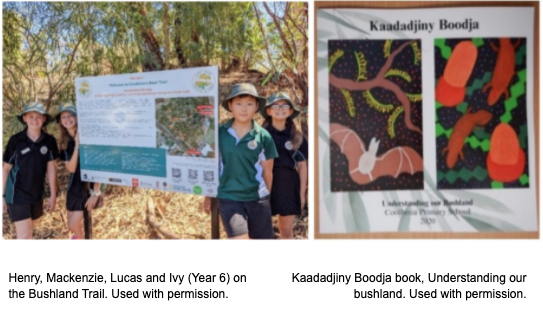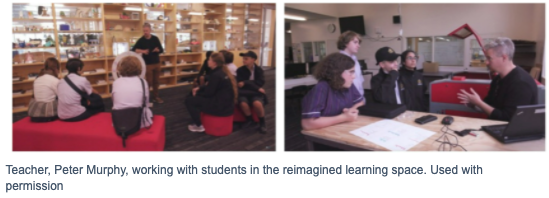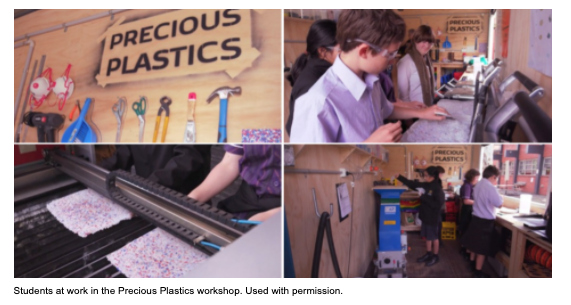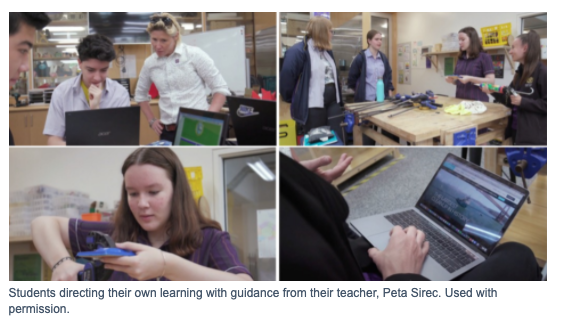
October 2021
Welcome to the October 2021 edition of the Digital Technologies in focus (DTiF) newsletter.
It’s a bumper issue. In this final stage of the project, we have been finalising the evaluation report and developing new resources on cyber security. More about the resources in the next newsletter.
New STEM illustrations of practice with a focus on Years 3 to 8 and a multi-age classroom have been published. See more information at the end of the newsletter.
The Leading Curriculum Change Using an Ecosystem Approach: Digital Technologies in focus: Supporting implementation of Digital Technologies evaluation report (June 2021) reports on ACARA’s National Innovation and Science Agenda funded project for the period June 2016 to June 2021.
This report is highly relevant to those with an interest in Digital Technologies curriculum, as well as to those with an interest in influencing curriculum change in disadvantaged schools and seeking to maximise the impact of teacher professional learning. The report and an external evaluation report prepared by Deakin University can be found in the About section of the DTiF website.
Regards,
Julie King,
Project Lead, Digital Technologies in focus
ACARA
What's new?
DTiF webpage
In the ‘Resources’ section we’ve added 3 new Digital system assessment tasks that provide scaffolds to teach about and assess your students’ understanding of how digital systems can be used to collect data and make judgements about how to cool your school both externally and internally.

Cooling the school: Years F–2
Students use digital systems such as photo apps and online maps to locate plants in the school environment and consider where new trees could be planted. Find this resource in the assessment section of the DTiF 'Planning' page.
Controlling the classroom learning environment: Years 7–8
Students record information using a range of digital systems and investigate how to monitor environmental conditions and design solutions to improve the learning environment in their school. Find this resource in the assessment section of the DTiF 'Planning' page.
Measuring and tracking environmental factors in the school: Years 9–10
Students record information using a range of digital systems and investigate the way microcontrollers can be used to monitor environmental conditions and design solutions to improve the environmental factors in their school. Find this resource in the assessment section of the DTiF 'Planning' page.
Download from DTiF Planing page
Map My School resources from She Maps

To complement our F-10 digital systems assessment tasks, you might be interested in checking out the Map My School resources.
Students can learn how to create, analyse, measure, map and communicate geospatial mapping principles and gain a better understanding of the amount of shade available at the school.
On the Webinars section of the DTiF website the DTiF in Conversation series of webinars feature rich discussions with a range of teachers and professionals. Guests discuss concepts which help make links to the Australian Curriculum: Digital Technologies.
Latest webinars include:
- Kevin Bradley and Cassandra Arkinstall, from Save the Bilby fund, on conservation work and how digital systems are used as they strive to save Australian endangered species.
- Paul Mead, from She Maps, challenges our perceptions about female role models and discusses unconscious bias. He also discusses a children’s book called Pippa and Dronie which promotes female role models in Science and Technology.
Leading Curriculum Change Using an Ecosystem Approach

The Digital Technologies in focus: Supporting implementation of Digital Technologies project has been a 5-year $7.88 million project. Working with the Project Lead, nine curriculum officers from ACARA supported 164 disadvantaged schools nationally to implement sustainable change in their approach to teaching Digital Technologies and develop the ICT capability of both teachers and students through action research.
The Leading Curriculum Change Using an Ecosystem Approach: Digital Technologies in focus: Supporting implementation of Digital Technologies evaluation report (June 2021) details the research methodology, a mixed-methods approach, and makes recommendations for those seeking to undertake similar action research projects and opportunities for further research.
The Digital Technologies in focus (DTiF) project used the key ideas of the Australian Curriculum: Technologies as the driver for developing technological content knowledge (TPACK) and Digital Technologies PCK as a framework for change.
Curriculum officers supported schools to manage change using a design process and the principles of action research. As part of each school’s professional learning ecosystem additional external support was identified for each school to sustain implementation.
The key findings from the report include the importance and value of:
• school leadership
• teacher commitment and professionalism
• teacher assistants, particularly in regional, remote and very remote communities
• student agency and student engagement
• connections beyond the school gate
• sustained engagement with curriculum officers over a few years.
Download the report
Farmhand at ‘Condo’ High School
By Shane Byrne
Students at Condobolin High School, in western New South Wales, were introduced to a new helper recently, they spent two terms experimenting with the Digital Farmhand robot.

Michael Forrai, Software Team Lead at Agerris,The University of Sydney start-up that supplied the Digital Farmhand, said: “Condobolin High students and Anne Earney (Head of Agriculture at the school) were great to work with. The students showed a real interest in learning about robotics and how the Digital Farmhand was contributing to the future of agriculture.”
“The purpose of the STEM Program was to introduce regional students to agricultural robotics and promote agriculture as an exciting career option through real life problem-based learning activities that are drawn from agricultural applications” Mr Forrai said.

Click the image to watch the video
The robot is designed to become a farmer’s digital chippy, plant adviser, sprayer, mapper, yield estimator and soon to come, harvester. Many students would be happy just using this range of features, but the Condobolin High Agriculture students had other ideas.
The students were incredibly creative when it came to creating additions for the Digital Farmhand and thinking of novel uses, such as designing and manufacturing a bracket to attach one of their own seeders. Not content with just one new application for the robot, they were also able to control it with an app using an iPad and even used it to herd animals from one area of the school to another.
This sort of ingenuity is exactly what the Agerris team were hoping for.
Ever mindful of the inherent risk of working with any farm machinery, the Agerris team was able to monitor the use of the Farmhand from their offices in Sydney. They could track exactly where it was, thanks to the inbuilt GPS, determine if the solar batteries needed recharging and even see what plants the robot was assessing — all in real time.

The engineers could also limit such things as the top speed that the robot would operate at while at the school. Only time will tell if robots like the Digital Farmhand will mean that kelpies across the country can join their best mate relaxing on the verandah a few hours early at the end of the day.
Cross-curriculum priorities at Coolbinia Primary School – Bush Trail
By Deanne Poole
DTiF partner school Coolbinia Primary is a metropolitan school, 7 km north of Perth which is fortunate enough to be nestled next to some open native bushland.

The K-6 school of around 400 students, aspired
to ‘provide a holistic approach to education and child development’. It is a vision pursued with passion by embedding the 3 Cross-curriculum priorities into all learning areas. All students from Foundation to Year 6 participate in a wide range of programs and projects that integrate the three priorities:
- Aboriginal and Torres Strait Islander Histories and Cultures
- Asia and Australia’s engagement with Asia
- Sustainability.
School Principal Paul Westcott said: “The Cross-curricular approach has ensured our students are exposed to a well-rounded curriculum that has direct links to the world in which they live locally, nationally and internationally. They are given opportunities to have a voice in their learning and how they can impact on others. Students can now see a purpose for what they do and have gained an understanding of how they can influence the world around them.”
Staff are supported by a STEM Committee led by Ian Wilson, STEM and Digital Technologies specialist teacher and Cross-curriculum Leader, Dr Elaine Lewis, who is a prominent leader in the field. Dr Lewis recently received the WA Department of Education 2021 Women of Achievement Award and was also named the inaugural Australian Sustainable Schools Teacher of the Year for 2020 by the Australian Association for Environmental Education. This award celebrates those teachers who best demonstrate leadership and innovation in sustainability across Australia.
“The successful implementation of integration of the Cross-curriculum priorities into all learning areas is evidenced by high levels of student engagement in consequential practical activities, along with significant skill development and application in the different learning areas,”
Dr Lewis said.

Led by the STEM Committee, the school created an interactive bushland experience for the community. Visitors can use QR codes to interact with what students have learnt about the area’s habitat and history.
Other technologies used in the development of or on the Bushland Trail include:
- augmented reality (AR) quiz developed by Year 6 students
- videos filmed and edited by Years 4 and 5 students
- Braille included, as researched by Year 3, to make the trail more inclusive and also connecting to representation of data in the Australian Curriculum: Digital Technologies
- QR codes created by Year 3 students that link to audio and visual bites of information created by Year 5 students
- software apps, including Publisher and Canva, for brochures produced by Year 4 students
- Excel used to collect and visualise data on the flora and fauna discovered on the trail by Years 4-6 and Sway to present research findings
- 360o photography and GPS co-ordinates of various locations used by Year 6 students to design a digital tour
- a mechanoid robot was programmed using Blockly programming language by Year 6 students to welcome guests to the trail.
Specialists, including Geoff Kaye from CSIRO STEM Professionals in Schools, and Coolbinia teachers and parents assisted with the bush trail project.
“Students overwhelmingly enjoy participating in lessons in Coolbinia's bushland 'outdoor’ classroom and student engagement and skills in Digital Technologies and STEM have been enhanced since starting the cross-curricular approach,”Dr Lewis said.
“Taking a two-way Science perspective, by bringing together Wadjak Noongar knowledge and western science methodology to enrich and deepen scientific understandings, was a vital contribution to Australia's reconciliation journey” she added.
What did the students say?
“I really liked that we and our school are a big part of the community around us. We used apps like Canva to create brochures to hand out to the community at the opening of the trail as well as some of the information that was on the boards in the trail. We also put Braille on the signs so that anyone, even if they’re blind, can read them because we were learning about codes in Digital Technologies,” Henry.
“In the future I hope our community encourage more people to explore the beauty of the bush land and understand how pollution, single use plastic, etc, is affecting the wonderful life beyond the trees,” Mackenzie.
Advice for schools who are interested in including more STEM, DT or Cross-curriculum priority integration
If you are considering introducing a cross-curricular approach at your school, Coolbinia Principal Paul Westcott suggests,
“Take on what is manageable to begin with and use the resources that are out there. It should be part of the teaching and learning program, not something we do on top. We have had some passionate people who drive the programs we run but it does take buy-in from all staff. Start small and you will be surprised at where it can take you”.
Dr Elaine Lewis recommends, “Including reference to more STEM, DT or cross-curricular integration in the school Business Plans and Operational Plans is an effective approach for other schools to adopt if they are investigating how they can include more of these curriculum features in their learning programs”.
Precious Plastics at Northcote High School
By Sarah Atkins
Northcote High School, in the inner northern suburbs of Melbourne has long taken a traditional approach to teaching Technologies, with specific classes for woodwork, metalwork, and textiles. There was also a significant gender divide between the subjects for the more than 1,800 Years 7-12 students.
Six years ago, the school embarked on a journey to reimagine STEM and rebuild the Technologies faculty with a design approach as central to learning. Staff and students adopted the United Nations Sustainable Development goals and from there, the Precious Plastics program was introduced.
Learn more about Precious Plastics

Peter Murphy, Design and Technologies teacher led the change during his three-year role as STEM leader. He set up a STEM leaders’ network with local schools and teachers visited each other’s schools to see what the common success factor was.
“The sustainability theme came through loud and clear that that was really useful for connecting all those different learning areas but also using the design process and design thinking as a model for all the projects for students to work through,” Mr Murphy said.
“So, when we had the opportunity to renovate this space, we wanted to make them more like design studios so that we could broaden the opportunities that the students had in designing technologies and connecting to different learning areas”.

One of the first steps the school took was to encourage teachers from different learning areas to create STEM units of work based on the existing curriculum with the focus on the design process as the underlying structure.
The teachers collectively chose to focus on the United Nations Sustainable Development Goals (UNSDG). All their units of work now incorporate problem solving, the design process, and tackle topics related to the UNSDG.
Learn more UNSDG Goals
One of the most successful programs has been Precious Plastics, part of a global movement collecting, processing and recycling plastics that can be granulated and re-formed to create sheets of plastic, extrusions or moulded directly into new products.
The process keeps plastic in a cyclic process and reduces the amount of recyclable material going to landfill. The Green Team at Northcote leads the collection and recycling of plastics in their purpose-built Precious Plastics recycling hub based in a shipping container in the school yard.
Students at Northcote High School are passionate about having an impact on the world.
Students are not only empowered through their involvement in the Precious Plastics program but also through their regular STEM classes. They have collected plastics from local schools and given presentations to students in neighbouring schools.

Teacher, Peta Sirec said student agency plays an important part in her approach.
“Being flexible and listening to the kids is really important,” she said. "If you're not listening to your students and you're just delivering content, then you're just delivering content”.
“Having a position of leadership associated with STEM is a clear signal to the school community that this matters to us. That enables someone to have oversight over what it is that you're doing in that area. Someone to draw a coherent narrative with everything else that you're doing as a school and connect it in and to remind everyone of how it connects to STEM and how we can broaden our opportunities in that area, and still connected to the rest of the strategic plan,” Principal Sue Harrop added.
See ACARA STEM Illustration of Practice
Do you know about…
Free teacher resources
Adobe is offering free teaching resources that might be useful for use during the design process. Teachers will need to sign up to access these resources.
Some examples include:




Have you seen the new STEM Connections illustrations of practice on the Australian Curriculum website?

Students investigated engineering themes through a novel study and designed and built their own model wind turbines. Students tested the efficiency of their wind turbines by collecting and analysing data through the use of micro:bits. |
|

To determine the success of each growing season, students compared wicking and non -wicking garden beds to identify which was better for plant survival. Students used micro:bits to measure current to indicate whether the garden beds were wet or dry. |
|

Students investigated and designed materials for cladding of a greenhouse, built models and used micro:bits to test their designs by measuring temperature data inside and outside the greenhouse models. |
Find these and other STEM Connections illustrations of practice on the
Australian Curriculum website.
Keep in touch!
There are many ways to connect and keep in touch... the newsletter, DTiF Wiki and the Digital Technologies Hub. Do you follow ACARA? Join our growing social media community.





Tell us what you think!
Email us at [email protected]. We'd love to hear from you.